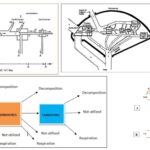IGCSE Biology 28 Views 1 Answers
Sourav PanLv 9November 15, 2024
Describe an ecosystem as a unit containing the community of organisms and their environment, interacting together
Describe an ecosystem as a unit containing the community of organisms and their environment, interacting together
Please login to save the post
Please login to submit an answer.
Sourav PanLv 9May 15, 2025
An ecosystem is a comprehensive unit that encompasses both the community of living organisms and their physical environment, interacting as a cohesive system. This concept highlights the intricate relationships between biotic (living) and abiotic (non-living) components, illustrating how they function together to sustain life.
Key Components of an Ecosystem
- Biotic Components: These include all living organisms within the ecosystem, categorized into various groups:
- Producers: Organisms, primarily plants and phytoplankton, that convert sunlight into energy through photosynthesis. They form the base of the food web.
- Consumers: Organisms that rely on other living things for energy. This group includes:
- Herbivores: Animals that eat plants (e.g., rabbits, deer).
- Carnivores: Animals that eat other animals (e.g., lions, hawks).
- Omnivores: Organisms that consume both plants and animals (e.g., humans, bears).
- Decomposers: Microorganisms and fungi that break down dead organic matter, recycling nutrients back into the ecosystem (e.g., bacteria, mushrooms).
- Abiotic Components: These are the non-living elements that influence the ecosystem, including:
- Climate: Temperature, precipitation, humidity, and seasonal variations affect the types of organisms that can thrive in an ecosystem.
- Soil: The composition and quality of soil determine plant growth and nutrient availability.
- Water: Availability of freshwater or saltwater influences the types of organisms present and their interactions.
- Light: Sunlight is essential for photosynthesis and affects plant growth and animal behavior.
Interactions Within an Ecosystem
Ecosystems are characterized by complex interactions among their components:
- Energy Flow: Energy from the sun is captured by producers and transferred through the food web as consumers eat producers and each other. This flow of energy is fundamental to ecosystem functioning.
- Nutrient Cycling: Nutrients such as carbon, nitrogen, and phosphorus cycle through ecosystems via processes like decomposition, respiration, and photosynthesis. Decomposers play a crucial role in returning nutrients to the soil.
- Habitat Creation: Organisms modify their environment in ways that create habitats for other species. For example, beavers build dams that create ponds, providing habitats for various aquatic organisms.
Examples of Ecosystems
- Forest Ecosystem: A temperate forest includes trees, shrubs, birds, mammals, insects, soil microorganisms, sunlight, water sources, and climate conditions—all interacting to form a balanced system.
- Aquatic Ecosystem: A coral reef ecosystem consists of corals (producers), fish (consumers), algae (producers), and various microorganisms interacting with water temperature, salinity, light availability, and substrate.
- Desert Ecosystem: In a desert ecosystem, cacti (producers), herbivores like kangaroo rats (consumers), carnivores like snakes (predators), along with abiotic factors like sand, minimal rainfall, and extreme temperatures interact to create a unique environment.
Importance of Ecosystems
Understanding ecosystems is crucial for several reasons:
- Biodiversity Conservation: Healthy ecosystems support diverse species; protecting them helps maintain biodiversity.
- Ecosystem Services: Ecosystems provide essential services such as clean air and water, pollination of crops, climate regulation, and soil fertility.
- Human Well-being: Ecosystems are vital for human survival; they provide resources like food, medicine, and raw materials while also contributing to cultural values and recreational opportunities.
0
0 likes
- Share on Facebook
- Share on Twitter
- Share on LinkedIn
0 found this helpful out of 0 votes
Helpful: 0%
Helpful: 0%
Was this page helpful?




